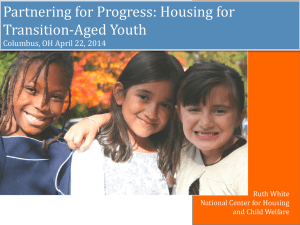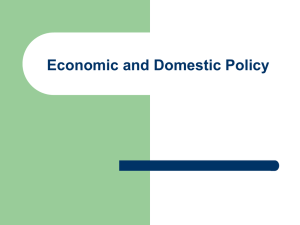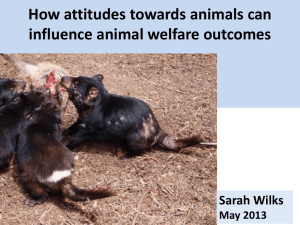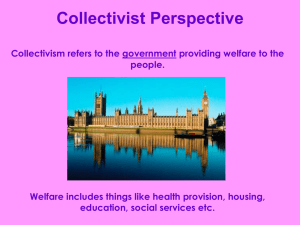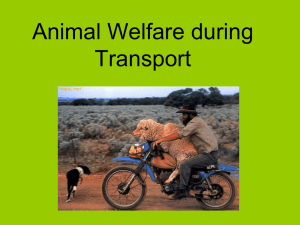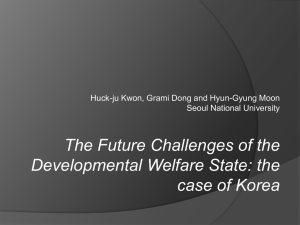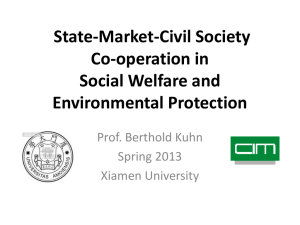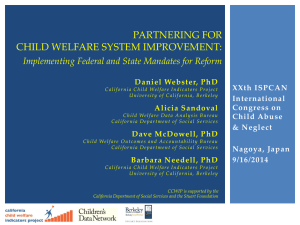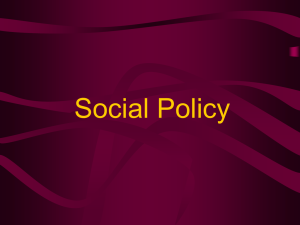direct practice
advertisement
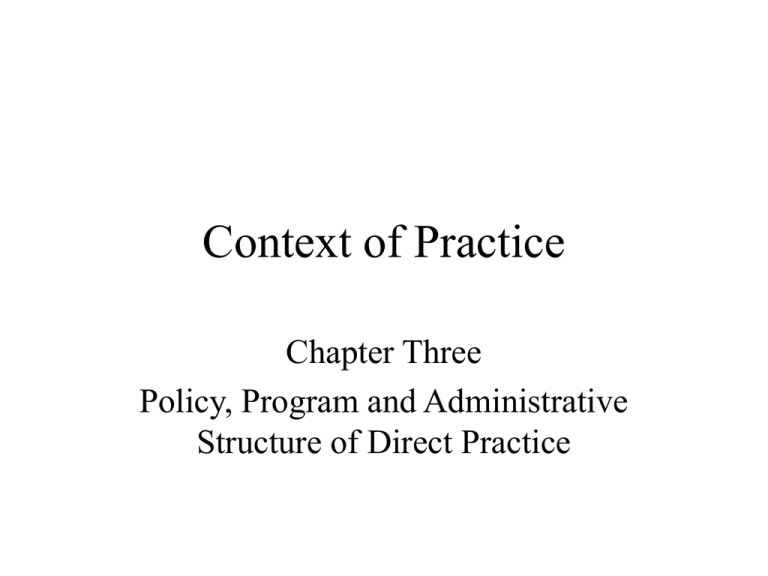
Context of Practice Chapter Three Policy, Program and Administrative Structure of Direct Practice Importance of Context of Practice • What a direct social work practitioner can or cannot do to meet client needs is constrained by the context within which the practitioner works • A context of practice has eight elements Elements of Context of Practice 1. Desired end goals: Contained in Mission Statements that articulate agency purpose and values (Social Justice) 2. Field of practice –An area of specialized practice i.e.Child and Family Welfare; Health and Mental Health; Each field has specific knowledge and terminology 3. Setting i.e. a place where services are offered i.e. social service agency, schools, hospitals, club houses Elements of Context-Continued 4. Program i.e. TANF; Medicaid-Medicare 5. Programs have procedures for determining eligibility and benefits 6. Policy regulates the program (TANF) and its procedures i.e. the Personal Responsibility and Work Opportunity Reconciliation Act (PRWORA, 1996) is a policy enacted into law that regulates TANF Elements of Context-Continued 7. An Organizational and Administrative Structure i.e. the Department of Family and Child Welfare administers the TANF program in a manner consistent with PRWORA policy and procedures 8. A client population i.e. Impoverished children and families Overview of Social Policy as a Context of Practice • In the Western world, Nation-states (i.e. Canada, the United States, the United Kingdom etc) enact certain policies to support two macro institutions: the economy (capitalism) and the government (democracy). These policies are often referred to as social (or welfare) policies. • There are two major social policy models: Keynesian and Schumpeterian. Keynesian Model of Social Welfare Policy • Holds that profitable growth and full employment are possible in a closed national economy; Belief in Capitalism and Democracy • Citizenship enables individuals to access a range of welfare benefits which may be universal (social security) or residual and need-based (TANF) • Model rectifies market failures but does not eradicate the market system Schumpeterian Workfare Model of Social Welfare Policy • Replaced Keynesian model • Model reflects government tendency to reduce social expenditures and curtail social spending • Imposes more demanding eligibility requirements and requires recipients of benefits to engage in paid employment • Places a CAP on benefits that may be received within a given time period; no longer universal entitlement to minimum economic support Comparison of Keynesian and Schumpeterian Models • Both models assume that an individual can attain a decent standard of living despite the unequal distribution of market-based incomes • Both models provide universal and selectiveresidual welfare services; safety net philosophy • In both models, local and regional state governments are relays for policies framed at the national level • Both rely on non-profit and private faith-based charities to augment services Ideology and Social Welfare • Values and ideology determine the desired endgoals of social policy • Science and evidence can document need (what is the prevalence and incidence of an identified social problem i.e. domestic violence?) and evaluate outcome (does a policy or program work?) but cannot determine policy goals. • Policy goals are value-based, normative, and prescriptive (desired good, what should be) Concept of Social Welfare • Because of competing ideologies, social welfare is a complex concept that carries certain tensions and contradictions; both stigmatizing and nonstigmatizing • It is a concept that reflects the end result of policyadvocacy aimed at reforming social institutions in order to respond to populations in need • It is a concept that acts as a function of social control and/or mechanism to maintain the status quo Desired End Goals Competing Ideologies • Radical Ideology: Structural change of major societal institutions (management/labor, health care, capitalism, education etc.) • Liberal Ideology: Reform of major societal institutions. Creation of a universal safety net i.e. Universal Health Care • Conservative Ideology: Residual, means-tested, temporary, safety-net. Individual and family responsibility. Faith-based and charitable initiatives. Welfare Social Justice and Social Control • Social Justice: Through welfare, social work policy advocates seek to reform institutions to build a humane and just society • Social Control: Through the norm of reciprocity (linked to work) and emphasis on individualism (linked to personal responsibility), welfare also functions as a means of social control designed to maintain the status quo Two Methods and Two Skill Sets • The ability to analyze, propose, advocate, implement (political/legislative social work ) and administer policy-based programs in social welfare requires skills in the methods of indirect practice. • The ability to deliver policy-based concrete services in face–to-face contact with individuals and families in an agency setting requires skills in the methods of direct practice Regulatory Context of Practice • CSWE Curriculum Standards- Degrees -BSW (Entry level) -MSW (Terminal practice degree) -PHD (Teaching and Research degree) • NASW Code of Ethics • Legal Regulation- Licensing Bachelor of Social Work • The BSW Degree is an undergraduate, entry level degree. Some students will graduate with a BA with a concentration or major in social work • If eligible, BSW graduates may apply for advanced standing in a Master of Social Work program • To practice, BSW graduates must pass an entry level licensing exam administered by the Association of Social Work Board Master of Social Work Degree • A two-year graduate degree • Is considered the terminal practice degree • First year provides a generic curriculum established by CSWE curriculum standards • Second year allows students to specialize in methods of practice: Clinical or social policy, advocacy, management or community practice. Field Internships • Both degrees, the BSW/BA and the MSW require course progression and experiential learning. • Experiential learning is provided by assignment to a field of practice in an agency setting i.e. field practicum or internship • On-site, licensed, MSW field instructors supervise students in their placements Association of Social Work Board • State legislatures or their equivalent enact enabling legislation to establish and empower a board to regulate the profession of social work • For social work this is the Association of Social Work Board • See: www.aswbdata.powerlynxhosting. Minimum Requirements for Licensure or Certification • Degree (BSW or MSW) from an CSWE accredited undergraduate or graduate program of social work • Experience and supervision • Successful completion of a competency exam Who Needs to be Licensed • Anyone who wishes to engage in direct practice with clients; clinical social workers • Those who practice strictly in policy, class advocacy, administrative, or community practice do not need to be licensed. • Regardless of concentration, all students in graduate schools of social work receive a Master of Social Work Degree. Four Types of Contracts The Profession is based on four contractual relationships: 1 Between society and the profession 2 Between the profession and the professional 3 Between the employer and employee 4 Between the worker and client Auspices Social workers practice under these auspices: (1) Public auspices - Family and Child Welfare (2) Not-for profit - Catholic, Jewish, and Lutheran social services (3) For-profit – Privatized behavioral managed care; EAP’s, private practice Social workers practice in primary (social service agencies) and host (hospitals, schools) settings Organizational Context of Practice • Social workers in direct practice work within an agency structure or in private practice. • All agencies have an administrative structure which is both formal and informal • All organizations have: a chain of command, a professional and support staff, a geographical catchement area that serves a particular client population, a prescribed route to service, intake and eligibility procedures and defined resources. Agency Mission Statements • Articulates agency purpose i.e. desired end goals • Are value-based -provide normative prescriptions -reflect theories of social justice -are ideological – “shoulds” • Adjust public resources through policies and programs to meet the need of client populations Direct Practice: Two Functions 1. Provision of concrete services associated with policy-based social welfare programs Uses case management (chapter 10) to serve highly vulnerable client populations 2 Provision of therapy or counseling to both highly vulnerable client populations and traditional clients. (Chapters 10, 12 and 13) Highly Vulnerable Clients • Those dependent on the State because of their age, their status as dependent, neglected, and abused children or their status as juvenile or adult offenders • Included are the homeless, those with chronic mental illness or mental disabilities. • Need long term concrete services from multiple providers - Step three of the decision tree. Context of Practice: Managed Behavioral Health Care • A “set of health care systems and technologies aimed at organizing and managing both the clinical and financial costs of service provision to a given population of customers” – Popple and Leighninger, 2002 • Treatment decisions rest with a third party, the insurer. Cost is a variable in treatment decisions. • Those in direct practice have a stake in the fiscal parameters governing the delivery of services Managed Care and Case Management • These are separate and distinct concepts • Managed care is a cost-containing system designed to regulate access to health and mental health services. A third party entity (HMO -the insurer) authorizes or denies treatment • Case management is a social work model of practice in direct practice that coordinates multiple fragmented services needed by highly vulnerable clients.

